
Tule Springs


Charles Rozaire photographs and clippings. Charles Rozaire Collection on Tule Springs, Nevada (MS-00100). UNLV Libraries Special Collections & Archives.
"Tule Springs is one of the few sites in the United States where evidence suggests the presence of man before 11,000 B.C.
Scientific evidence shows this area, once covered with sagebrush and bordered with yellow-pine forests, had many springs. These springs were centers of activity for both big game animals and human predators. Evidence shown at these fossil springs shows the presence, 14,000 to 11,000 years ago, of several extinct animals: the ground sloth, mammoth, prehistoric horse, and American camel. The first Nevada record of the extinct giant condor comes from Tule Springs.
Early man, perhaps living in the valley as early as 13,000 years ago, and definitely present 11,000 years ago, was a hunter of the big game.
Small populations of desert culture people, from about 7,000 years ago to the historic period, depended upon vegetable foods and small game for subsistence.
Late Pleistocene geological stratigraphy in few other areas is as complete and well known."
(Nevada Historical Marker 86)
Listed on the National Register of Historic Places in 1979 (Address Restricted).
Listed on the Nevada State Register of Historic Places in 1981.
Listed as a National Monument in 2014 (Tule Springs Fossil Beds National Monument).
Located at the Tule Springs Fossil Beds National Monument.